Welcome to my final In-Depth presentation involving my key takeaways from learning Rhinoceros 3D (3D modelling software) throughout the past 6 months. During this period, I have gained skill/knowledge about Rhino Software, as well as learned to handle and profit from the many difficulties encountered when learning a new skill. Throughout the 6 months, I have been progressively learning, as well as experimenting with the software to familiarize myself with its capabilities. Embarking on a number of projects, they challenged my existing knowledge about the software and forced me into new situations/opportunities for learning. I will be demonstrating my latest creation, a remodelled version of Dieter Ram’s “Audio 300”.
Completed RTX Render of Dieter Ram’s “Audio 300” (extremely beautiful)
RTX Rendering Process inside Rhino Render
Painfully long rendering wait time
Front view of “Audio 300” Perspective [pre-rtx rendering, faster than rtx] (textured)
Front-Side view of “Audio 300” Perspective [pre-rtx rendering, faster than rtx]
Behind View of “Audio 300” Perspective [pre-rtx rendering, faster than rtx]
Front-Zoom view of “Audio 300” perspective [pre-rtx rendering, faster than rtx]
Font-Zoom view (2) of “Audio 300” perspective [pre-rtx rendering, faster than rtx]
Front technical view of “Audio 300” perspective [shaded]
Top view of “Audio 300” top plate only perspective [shaded]
Top view of “Audio 300” top plate cutouts only perspective [shaded]
Image Draft Resource used for reference “Audio 300”
Real Image of the Audio 300 designed by Dieter Rams (Braun)
In this journey of learning, I have recognized one specific key to success in learning skills which involve creating, etc. The key is to always construct reasonable, yet valuable projects which would benefit you short, and long term. Projects allow you to experience, make mistakes, learn, and accomplish. Simplifying the construction process, you have to involve a few main components when constructing a project. First, choosing a goal that is SMART (Specific, Measurable, Attainable, Relevant, Timely). Using that goal, recognize a brief of the steps needed to accomplish that goal (understand this may and will be subject to change). Be satisfied in your desired result, because it will make you happier when you do reach that milestone. Lastly, make sure there is sufficient challenges in your project. When roleplaying the lifespan of the project in your head, there should be parts that feel somewhat unrealistic, however, it also shouldn’t be such a big leap that you are not dedicated to take. The main point in all of this is to enjoy the challenges in the learning you embark in through projects (specifically the projects you dedicated yourself to).
I was embarking on a wild 6 month-long Learning Expedition. Sitting in my Safari expedition vehicle, Outlooking into the wild jungle of sysadmin trees and a specific species of Emaille vine called qmtk. That’s where I saw, hiding behind the sysadmin tree, a pack of Rhinos in 3D! This pack of Rhinos stuck together no matter what. When I tried to lure a single one of them near the qmtk vines, all of them followed closely. I thought, interesting… how can it be so painfully hard to separate a pack of Rhinos? That’s when I turned my attention to the guy sitting inside my Safari expedition vehicle, Professor G (last name oogle). Professor G (last name oogle) was a know it all, so I advised for his opinion, and asked: “how to separate rhnio pack stuck together?”. In which he replied “Did you mean: How to separate Rhino pack grouped together?” and proceeded to show me images of more 3D Rhinos. At that point I knew professor G (last name oogle) was having a temper trying to correct me and all, thus, I made the decision to take initiative and examine the situation myself. I advanced closer towards the Rhinos and inferred that they were scared to leave each other, mainly because of old habits from being together. Conveniently, I directed my attention to the qmtk vine and saw a pack of non-dangerous firecrackers beside it. I calculated that if I were to ignite the firecracker at the middle of the pack, they would finally be separated from the pack. And that was what I did, I ignited the firecracker, chucked it straight in the middle of the rhino pack, and boom, they ran away from it.
Now, to clarify the context of this poetic masterpiece, I had ran into a problem separating a 3D grouped object in one of my designs. However, when I commanded the usual ungroup, the object was still intact as one object. I had been confused to why this was and attempted googling it, however there was a lack of vocabulary to describe the specific situation, therefore I did not find a solution on google. However, when experimenting with a few of the tools inside the software itself, I was introduced to the explode tool (used for separating 3D objects into 2d Planes). This command allowed me to separate the 3D object and successfully get the shape I required.
Thank you for following along with my learning journey, I hope this has been an enjoyable semi-end to this project!
Later,
Hanson

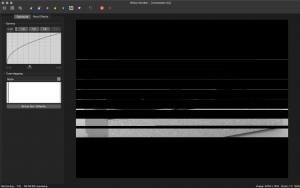
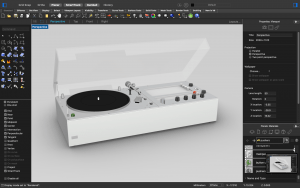

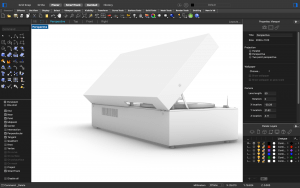


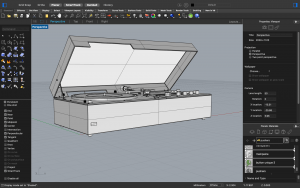
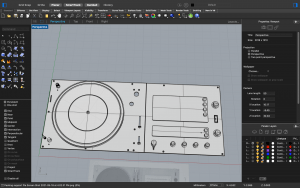

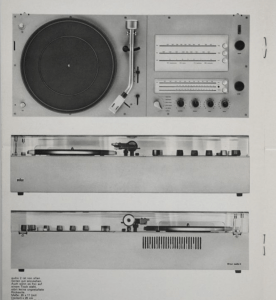

Love your poetic master piece. Very creative. Why did you decide on the Dieter Ram’s “Audio 300” as the main part of your project?
Mulder (also known as qmtk!)
Thank you Ms. Mulder for the kind reply. I am indeed very proud of my poetic masterpiece. I chose to model Audio 300 because it was a reasonable stretch and had a good level of complexity. I saw opportunities to learn and places where I did not know how to make yet. For that reason, it was simply a good balance of learning and a beautiful machine to render when completed.
– Hanson
Thank you, Hanson, for taking me on this safari! I really appreciate the extended metaphor that you wrote to document a challenge you encountered in ungrouping. Do you think there was a solution or is there an embedded need to problem solve using indirect strategies as you did with the exploding tool.
You mentioned that it’s important to set up challenges for yourself..what was the single biggest challenge you encountered..how did you overcome it? Why did you want to learn how to 3D render? Do you have an interest in design and architecture? What is the benefit of rendering as a design skill? What can it do that a photograph can not? Thanks, Hanson! Impressive final rendering.
Hello Ms. Quach, thank you so much for the detailed reply. To directly answer your first question, the single biggest challenge I have was when I first interacted with the software. The interface needed time to get used to, therefore requiring some time to learn. However, through experimentation and creating a few things on my own, I could apply the information to solidify it into skills.
I also started to learn this software because it is widely known in architecture, industrial design, etc. I do have an interest in architecture, therefore attracting me to this skill because I would have a wider variety to express my ideas. And specifically answering your question, what can renderings do that a photograph cannot, to a certain extent everything photographed can be done in render, however since renderings do not require a physical object it has a wider range to capture images from. This form also allows the designer to make changes easily, which is sometimes harder in real life to manipulate a physical object.
– Hanson
That render looks amazing, Hanson! I bet if you actually rendered it fully, it would look even better! You made it look almsot exactly like the real thing, which amazes me! Great job!
Dylan
Thank you, Dylan, for the kind comment, it would have looked better, however, the wait time would be significantly longer. I decided to just balance the time as well as the quality.
Good evening, Hanson.
I thoroughly enjoyed reading through your blog post. I found it to be quite detailed and well written. I specifically enjoyed the poetic master piece you wrote. The pictures of the “Audio 300” you constructed were impressive. But it left me wondering, what other objects/models did you create using rhino?
Thank you
-Lucas
Hello Lucas, thank you for the kind response. In the process of learning this software, I have also made a fire-extinguisher from a tutorial as well as some household objects I used to experiment with.
– Hanson
Great post to showcase your learning, loved the render (it’s super clean). Now you have to 3d print it and put it to use! 👏👏🎵
Thank you for admiring my super clean rendering. I might potentially 3D print a version of this however balancing the size will be difficult as 3D printed objects look quite abstract when printed at a smaller scale.
Haha, the poem is very funny. I love the “subtle” deeper meanings it conveys. It was also neat to see you show the general learning you gained from this indirectly with making the right type of project. Your 3D object looks amazing, full of intricate details and design aspects, great job!
Thank you Ben for the kind comment, yes I have worked quite hard on my poetry. Glad you enjoyed it.
– Hanson
I find this super interesting, but it also looks very complicated. Overall it was pretty fun to read through, and by the way, I think you should go into poetry next year. Great work Hanson!
Thank you Adrien, I just might go into poetry since I have demonstrated such unrivalled talent.
– Hanson
Whoa! Your project is super cool and unique! Amazing effort and presentation. You should be proud of your In-Depth learning centre and work!
This is so cool Hanson! I really enjoyed how you talked about the process of learning in your blog post and gave valuable tips and advice. I hope some of that sticks for me! I also really enjoyed seeing all of your work on your 3D object. This is a subject I’ve always wanted to learn about and you did an amazing job! I love the choice of subject to render and your thorough explanation. What is your favourite thing about 3D rendering?
Thank you Bana for the kind response. I would say that my favourite thing about 3D rendering is the many ways digital 3D objects can be applied. This skill have the ability to affect many professions, and can be helpful to many circumstances.
– Hanson
Good evening, Hanson. You have truly created a poetic masterpiece. Do you plan on continuing to learn 3D modelling? And if you do, do you plan on continuing to use Rhino?
Thank you Mike for appreciating my Poetic Masterpiece. Yes, I will be continuing to apply my 3D modelling skill to architectural settings which would be more relevant to my interests.
– Hanson
I can only imagine the amount of patience you needed for this project.
Mrs. Chambers
Thank you so much Ms. Chambers for the kind reply, in fact, I did not require extensive patience because I was so engaged in the topic.
– Hanson